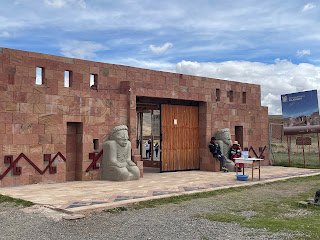We drove this morning to Tiwanaku, Bolivia's most important archaeological site. It was another long drive, and retraced some of the route we suffered over yesterday. Somebody really needs to revise this itinerary to make the travel more efficient.
The drive was across Bolivia's high central plateau. The land is reminiscent of Wyoming or Montana, with isolated farmsteads and small settlements scattered about. The land is primarily good for grazing, although there are small plots of crops. One thing we noticed is that there are no fences. Cattle are put on on a rope leash staked to the ground. Sheep seem to wander by themselves, though people are around.
Tiwanaku was the primary temple site for the Tiwanaku culture, which covered most of modern-day Bolivia and Peru, as well as portions of Chile and Argentina, from roughly 600 B.C.E. until being conquered by the Incans sometime around 1100 C.E.
We visited the museum first, guided by Williams, our tour leader. Over the course of their 1700 years, the Tiwanaku civilization developed to a high degree, giving rise to modern speculations about their having been visited by aliens from space who gave them secrets. They practiced medicine, including brain surgery (evidence shows the patients actually survived!), were master engineers and architects, and had elaborate astronomical knowledge. The empire was a theocracy, with the priests serving as the ruling class.
Unfortunately, the site has been heavily looted and used as a quarry from which the finely finished stones could be carted away for other building projects. For instance, the large church in the nearby village was constructed almost entirely with stone stolen from the temples. Fortunately, recent archaeological studies suggest that only about 4% of the site has been surfaced, and that many other treasures remain to be uncovered.
The site consists of a large, rectangular pyramid about 50 feet tall, plus several smaller structures. Reconstruction has been very limited. The pyramid is an earthwork, constructed much like the agricultural terraces we've seen, and had a sun temple on top. The totem animal for the sun god was the condor.
Another small temple was dedicated to the moon and stars. Not much remains of that structure.
A temple dug into the ground was dedicated to the underworld. This structure is well preserved because it was buried by floods and only recently uncovered. The totem animal here was the snake.
Finally, a ground-level temple site has been reconstructed. This temple was dedicated to the earth with the puma serving as the totem animal. All of the temples are perfectly aligned withe the cardinal points of the compass.
Everything in the design of the temples revolves around the number seven. The pyramid consists of seven levels, with seven steps leading to each. There are seven stones in each horizontal line, separated by 14 verticals on the east and west ends, and by 28 verticals on the north and south sides.
Some of the statues are very well preserved, and are noteworthy in that they have two arms, both with left hands. Apparently, left-handed people were considered gifted, and the leaders particularly so.
A short drive into the village brought us to a very nice restaurant for lunch, where we enjoyed llama steaks. I thought it tasted a lot like lamb, and it certainly had that texture. Some others thought it tasted more like pork.
The long, slow drive back to La Paz took us into the heart of the old city. We walked for several blocks through the old, narrow streets surrounded by 18th century Spanish mansions. Many of these buildings have been repurposed as museums and schools.
In the central square, we viewed the exteriors of the parliament building and the presidential palace. The old colonial buildings remain, but rather ugly, glass and steel modern high-rises immediately behind them are where the political action now takes place. The president lives in the penthouse of an administrative sky-scraper!
One oddity is a clock that moves backwards that was installed on the parliament building by a recent former president who sought to make a reputation as a politician who shakes things up and defies tradition. Another feature of the square is an enormous number of pigeons.
Also on the square is the Cathedral. Built in the 1800s, it is constructed of local stone, but finished entirely with Italian marble. Tons and tons of marble, as well as delicate sculptures, had to be brought from Europe. Because the railroad had not yet been completed, most of the stone and fragile statues had to be brought hundreds of miles on donkey carts!
After returning to the hotel, we got packed and tried to rest a bit. Our departure for the airport is just after midnight. Because of the high altitude, large jets only will attempt to take off from here in the coolest early morning hours. We were just beginning to feel as if we had caught up on sleep, but we won't get much tonight.
















No comments:
Post a Comment